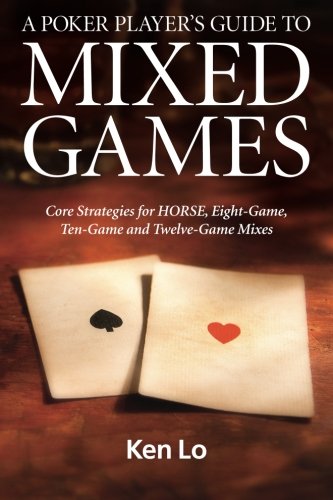Badeucey Rules and Basic Strategy
Rules of the Game
Badeucey is a split pot game where the object is the make the best deuce to seven low along with the best badugi. In Deuce to Seven Lowball straights count against you so the best low is 23457. In Badugi you aim to get the lowest hand possible with cards in different suits and of different ranks. If you obtain a hand with four unpaired unsuited cards you have a badugi e.g 8♣ 7♥ 5♦ 2♠.
In Badeucey the aces are considered high so the best possible hand for the badugi half would be 2345 of all different suits. If you do not have a badugi then your hand is considered “incomplete”. If you have three unpaired unsuited cards (e.g. J♠ 8♠ 5♥ 2♣ or 8♠ 5♥ 2♣ 2♦) you have what is known as a three card badugi or tri hand. As in regular Badugi, any badugi beats a tri hand.
Badeucey has become one of the more popular games; it is almost always included in any mixed rotation that includes draw variants.
Basic Strategy
Badeucey is a split pot game and as such your main goal is to play hands that have a chance to win both halves of the pot.
Everyone is dealt five cards so it is much more likely that you will be dealt a badugi from the onset and the ability to draw two cards to a tri hand means that that the average badugi at showdown is much stronger. Thus in Badeucey you must discard any notion of starting with a ten or higher badugi and hope it holds it in a multi-way pot. Even in a heads-up pot keeping the ten is precarious because when doing so you are obviously capping the best deuce to seven low you can make at the ten. For the most part, you should also discard a nine even if it makes a badugi.
Initially your starting hand selection and strategy should be geared towards making an 8 five card low along with a 7 badugi. It is very rare to be dealt either one of these hands from the onset so usually you will be entering a pot with a three card unsuited hand such as 2♣3♥7♦. Four cards, the 4♠, 5♠, 6♠, and 8♠ are extremely helpful in that you will make a badugi as well as gain at least a four card eight on the low side. Twelve other cards, the remaining fours, fives, sixes, and eights will give you at least a four card eight low with a tri. At that point you have made progress towards building a hand that can scoop, or can hopefully at least get one half of the pot. Drawing two with these sixteen “outs” you will improve one way or another approximately 57% of the time.
If you are lucky enough to make a strong badugi early the play is to bet and raise at every opportunity for both value and protection. Even in the unfortunate situation that you do not have the best badugi you still have a chance to win the five card low side and there is still a chance to improve your badugi along the way.
Cards such as the 4♥, 5♥, and 6♥ will not give you a badugi or improve your tri hand but they are probably too valuable on the five card low side to consider discarding. So they should probably be kept whether the pot is multi-way or heads-up. The 8♥ is a more difficult decision. Multi-way I would discard it but heads-up against a single player who drew two or three it is enticing to keep this improvement. Your opponent may fear you have a strong badugi and fold after the second draw if they are still drawing two. And when they don’t fold you have a lesser chance of being scooped because you would be the favorite on the five card low side.
If the object of the game is to scoop your opponents, the opposite is also true in that you must try and prevent yourself from being scooped. On the river, unless the pot is small you should tend to call if you have a reasonable chance to win one way or another. It is not out of the question that your opponent has a hand like 2♣ 3♥ 4♥ 7♦ 7♠ in which case you will often have a hand that will scoop.
Starting Hand Standards
Since it is a split pot game you must be play tighter in early position than you would in one winner games. But as you progress to the later positions you can open much wider as you now have valuable position and possibly a chance to win uncontested. Below is a reasonable set of opening ranges by position:
Early position: (12.5% Hands)
- Pat 8s or better
- Premium 7 Draws (e.g. 2347) – Rainbow or w/ Three Suits
- Straight 7 Draws w/ deuce (2345-2456) – Rainbow or w/ Three Suits
- 3456, 3457, 3467, 3567 – Rainbow or w/ Three Suits
- One card to draw to an 86 or an 87 with a deuce (e.g. 8643 or 8732) – Rainbow or w/ Three Suits
- 234-267 Rainbow
- 238-258 Rainbow
- 345, 346, 347, 356, 357 Rainbow
Hijack: (14.2% Hands)
- Early Position Hands
- 268, 278 Rainbow
- 367 Rainbow
- Premium 7 Draws (e.g. 2347) – Two Suits
Cut-off: (23.9% Hands)
- Hijack Hands
- 348-378, 456-458, 467 Rainbow
- 234-267 – Two Suits
- 27 Rainbow
Button: (40.4% Hands)
- Cut-off Hands
- 468, 568, 567 Rainbow
- Straight 7 Draws w/ deuce (2345-2456) – Two Suits
- 3456, 3457, 3467, 3567 – Two Suits
- One card to draw to an 86 or an 87 with a deuce (e.g. 8643 or 8732) – Two Suits
- 23-26, 34, 35, 37 Rainbow
Further Learning
A Poker Player’s Guide to Mixed Games by Ken Lo (Rating 7/10) – This book is worthwhile for any mixed games player and there is a sizeable chapter on Badeucey within the book. It serves as a good introduction to the game but it reads too much like a textbook and is very repetitive. In addition there are a few concerns regarding some of the advice given within the text.
He ranks starting hands by Tier and considers Tier 1 to be solely comprised of 7 high pat hands with a badugi. These monster hands are very rare so it seems somewhat odd that they would occupy their own tier. Tier 2 is comprised of 8 high pat hands with a badugi, 7 high pat hands without a badugi, and made badugis 7 or lower. According to Lo, only the Tier 1 and Tier 2 hands are playable from any position. Hands such as 8♠ 5♠ 4♦ 3♠ 2♥ and 7♠ 4♥ 3♠ 2♣ are in what he considers to be Tier 3and folding any of them from early position would be incredibly tight. You would be playing less than 3% of your hands. Tight is right in early position in split pot games but not that tight. None of those hands should be folded regardless of the lineup and your experience level.
Another concern is that a large part of the chapter deals with simulations regarding discard decisions and how often keeping or discarding will allow you to make either an eight low, an eight badugi, or both. These simulations appear to ignore too many important factors such as fold equity and playability thus it is hard to draw any concrete conclusions from the analysis.


